For the ultimate skin-soothing bar of soap, you can’t get much better than this Baking Soda Oatmeal Bar. Made with Castile Rebatch, Oat Extract, Colloidal Oatmeal and baking soda, it has some serious nourishing power. Baking soda provides gentle all-over exfoliation, and oatmeal is renowned for its ability to calm irritate skin. Some customers may prefer this bar unscented so they can enjoy the gentle exfoliation of the baking soda and soothing effect of the oatmeal, but you can certainly add Lavender or Chamomile Essential Oil to give it a mild scent.
Regular soap has a pH anywhere from 8.5 – 10, and this soap is definitely on the low end of the spectrum with a pH of 8. It’s gentle enough for sensitive skin but strong enough to provide plenty of exfoliating cleanliness.
This is also a great recipe for beginning cold process soapers. It uses a rebatch base, which means the soap arrives pre-made and pre-cured; no dealing with lye! This tutorial uses the double-boiler method, but you can experiment with the plastic baggie technique too. For more on making rebatch soap, check out this Soap Queen TV video.
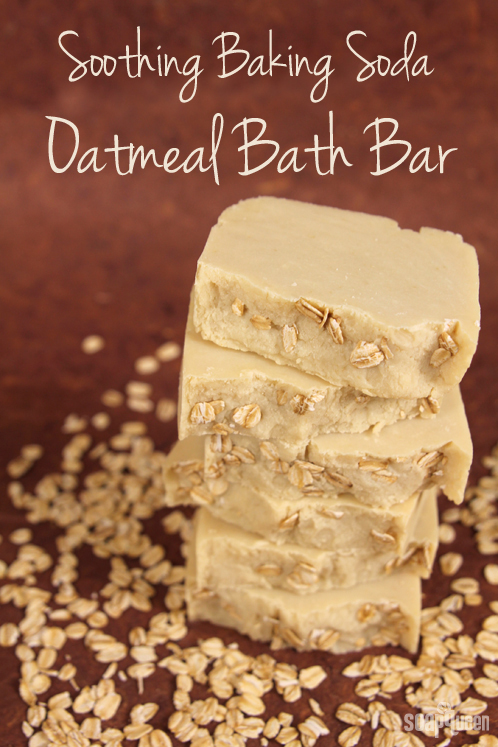
What You’ll Need:
16 oz. Castile Rebatch
16 oz. Sodium Bicarbonate
3.2 oz distilled water
.2 oz. Oat Extract
.5 oz. Colloidal Oatmeal
.2 oz. Rolled Oats
.8 oz fragrance or essential oil (optional)
2 lb. Wood Loaf Mold with Liner
 Click here to add everything you need for this project to your Bramble Berry shopping cart!
Click here to add everything you need for this project to your Bramble Berry shopping cart!
ONE: The rebatch you order from Bramble Berry comes pre-shredded, so you won’t need to worry about that. Set your double boiler on medium heat and add the rebatch. Let the rebatch sit and move on to step 2.

TWO: Mix the baking soda with 3 oz. of distilled water. Stir with a whisk or spoon to combine.

THREE: Add the entirety of the baking soda/water mixture to the rebtach and stir.

FOUR: Add the Colloidal Oatmeal. At this point, the rebatch should start to melt down into more of a paste. If it hasn’t, keep stirring and turn up the heat slightly on the double-boiler.

FIVE: At the Oat Extract and stir.

SIX: Now play the waiting game! After about 20 minutes, the rebatch will start to thicken into a gloppy oatmeal-like texture. That’s what you want. You want to keep your rebatch hydrated, so you may need to add a little extra water if you notice any cracking or if the mixture turns to a clay-like consistency. Keep in mind that the more liquid you add, the softer the soap will be, and the more difficult to pop out of the mold.

We added a tiny (.2 oz) of extra water to keep the soap from getting too dry.
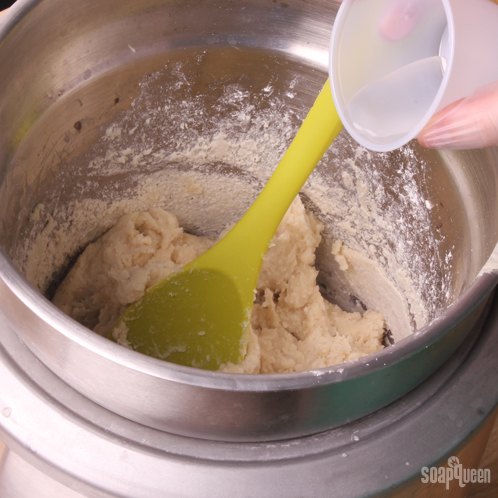
SEVEN: As you can see below, the ideal texture is that of mashed potatoes. At this point you’re ready to spoon it into the mold.

EIGHT: We used a Round Silicone Spoon to scoop the soap into the mold. Because it’s so thick, remember to tamp the mold on the table to eliminate any trapped air bubbles. Garnish with rolled oats.
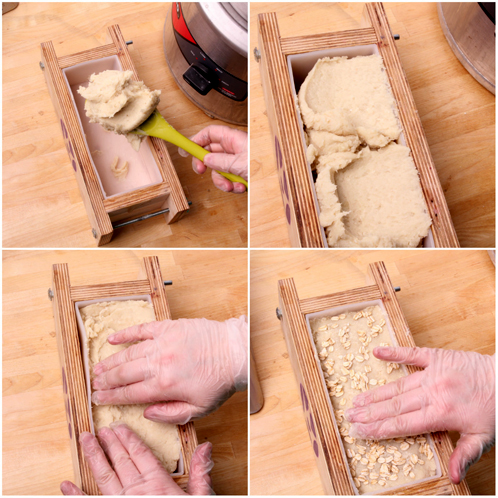
Wait 2 to 4 days before unmolding. When send our rebatch already cured, so as soon as you cut it’s ready to use right away. Enjoy!

UPDATE:
Many of you have been asking about adding baking soda to regular cold process batter. Our research and development team tested a batch using the same amounts of water and baking soda we used in this recipe, and the results are below:
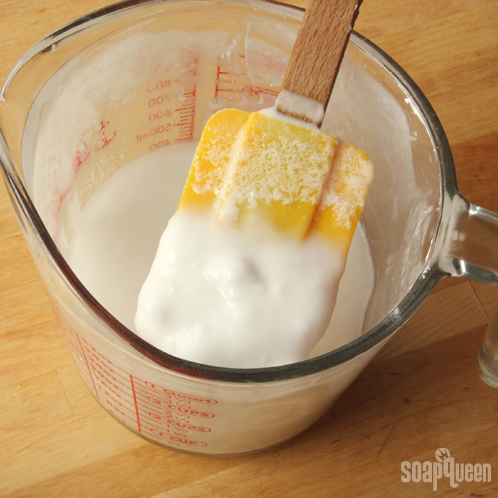
Lye water and baking soda. Those are chunks are undissolved lye!
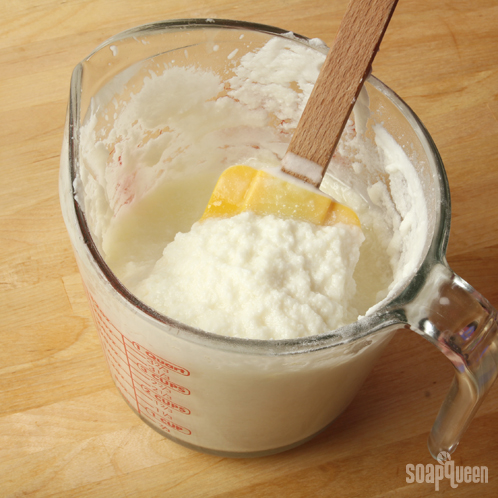
Lye water, baking soda and oil. Even after vigorous stick blending, the mixture still wouldn’t combine.
So there you have it! These photos definitely speak for themselves. While we don’t know exactly why baking soda reacts so poorly with lye and soap batter, our guess it has something to do with the baking soda and lye neutralizing each other, thereby interrupting the saponification process. When it comes to baking soda and soap, stick to rebatch!


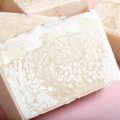
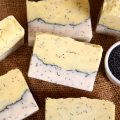

I tried this recipe with the goat milk rebatch. I scented it with the milk, honey and milk fragrance oil. I cut the bars today and it turned out perfect. Please give us more rebatch recipes!
I love the Goat Milk Rebatch, it’s so nice and creamy! Also, thanks so much for your suggestion. We’ll definitely keep that in mind for future tutorials. 🙂
Goat Milk Rebatch: https://www.brambleberry.com/Grated-Rebatch-Soap-Base-Goat-Milk-P4605.aspx
Oatmeal Milk and Honey Fragrance Oil: https://www.brambleberry.com/Oatmeal-Milk-And-Honey-Fragrance-Oil-P3931.aspx
-Kelsey with Bramble Berry
So… What if the baking soda were added just prior to pouring, after the lye solution and oil had already been mixed?
Hi Jennifer!
I’m not exactly sure, we didn’t try that out! My worry is that the baking soda would react with the unsaponified lye in the soap batter and start to clump it, much like it did to the lye water. Baking soda seems to interrupt the saponification process, leaving that lye as is. I wouldn’t recommend using baking soda in cold process soap.
-Kelsey with Bramble Berry
Hay, I have been making a bicarb cold process soap for a long time with no problem at all I add the bicarb and white clay powders at trace and I have never had a problem! I only add about 2% in but it makes a beautiful bar!
That’s awesome, thanks so much for sharing! How does the bar feel on the skin? 🙂
-Kelsey with Bramble Berry
Hi I just was wandering if you could make rebatch with an infused herb oil ?
If so how much could you use for this soap recipe?
Hi Robin!
Adding extra oil to your rebatch base can be a bit tricky. Because the base has already turned into soap, adding oil can make it greasy or oily. If you do add it, we recommend about 1 teaspoon of oil per pound of rebatch. That should give you the benefits of the oil without affecting the final texture of the soap too much. 🙂
You can add infused oils if you like! Learn more about infusing oils with a Crock-Pot here: http://www.soapqueen.com/bath-and-body-tutorials/tips-and-tricks/how-to-infuse-oils-with-a-crock-pot/
-Kelsey with Bramble Berry
Thanks Kelsey.
I had forgotten about that tutorial on infusing oils I’m definitely going to watch that video again.
You’re welcome! 🙂
-Kelsey with Bramble Berry
I used a Reynolds oven bag twist tied tight in boiling water with success to utilize this recipe to rebatch my own melt and pour oatmeal soap that smelled wrong because of a mistake with EO.
I had 1 pound of soap cut up in small pieces with my soap cutter…. added 1 pound of baking soda, and I added 3 ounces of water like you say in the above recipe. In less than 1/2 hour the soap was liquid and ready to take out of the water and allow to cool a bit down below 100 degrees. I opened the bag then added new almond Fragrance oil 1/2 ounce worth. Thank God it smelled better. After it cooled enough to manage and began to thicken I spooned it into my loaf mold. after 3 day7s I dumped it out of the mold and sliced it into large bars to continue to dry out. It is soft and still damp. gonna wait a week and check again to see if I can finish slicing it. I think it’s too wet because 3 ounces of water was too much water. I’m now concerned that from what I’ve read on your site. that the baking soda may make the soap not give forth lather. I don’t want that to be the case. My reason for adding the baking soda was to increase the already exfoliation properties that my having added oats in the first go round worked. I won’t know this for sure till it finishes drying out and hopefully becomes hard. any thoughts anyone??? will I now sacrifice lather? did the above recipe using the stock re batch soap not lather because of the addition of so much baking soda?
on reflection. when I make new batch of M&P would a teaspoon per pound of baking soda cause my recipe not lather?
Hi Jean!
Baking soda can inhibit the lather in the recipe, even when using the Basic Rebatch. This recipe was designed to be gentle and exfoliating, but won’t have as much lather as other soaps.
The great news is it feels great, and helps exfoliate so your skin feels fresh and clean.
If you’re wanting a base with stable lather, you’ll love our Luxury Rebatch: https://www.brambleberry.com/Grated-Rebatch-Soap-Luxury–P4543.aspx
We also have a lot of great exfoliants that don’t affect the lather, like shredded loofah. You can learn about those exfoliants and which one to use in the All About the Exfoliants post: http://www.soapqueen.com/bath-and-body-tutorials/tips-and-tricks/all-about-exfoliants/
-Kelsey with Bramble Berry
Thank you Kelsey for your prompt response! I’ check out the tutorial and also let you know how my soap does after it finally dries out. Its almost a week and I’ve wrapped it up in a diaper material and put it in a box in the sun during the daytime. It is starting to harden and dry out. I appreciate your ideas. The rebatch you’re referring to that the lather isn’t affected.. Do I get to just melt and pour that or do I need to use my oven bag method in boiling water?
You’re welcome! I’m sorry, I’m a little confused by your question. Are you asking how to work with melt and pour? Let me know and I’ll help you out. 🙂
-Kelsey with Bramble Berry
Yes Kelsey I’m asking about melt and pour soap base. adding how much baking soda to not retard lather.
many thanks
Jean
Update: :0)
By the way the re batch I did in order to fix a melt and pour oatmeal soap that smelled bad (see reference above) . update: I took a pound of the bad soap bars
I made. chopped them up added 1 pound of baking soda. used your re batch recipe using a Reynolds oven bag …etc. see above….and now after 2 weeks of drying out the bars. I want you to know it makes great lather! i’m very pleased with the baking soda working out with the oatmeal soap re batch from bad soap smell from previous melt and pour recipe.
my new question to you has to do with the first time around using regular melt and pour base I add my oats and I wanted to also add baking soda to it as well but not so much as to retard the lather. should I stick with a couple tablespoons per 8 ounces of melt and pour or less? many thanks!!!
again I’m not using re batch base this time just using the regular brand new melt and pour base.
Jean
well I successfully added cornmeal and ground oatmeal together to my melt and pour soap recipe! next time I’ll use white sugar instead of the cornmeal. The cornmeal gets soft just like the oatmeal to give gentle exfoliation. I want it to have more kick though, so next time I’ll add white sugar to the oatmeal and let you know. wanting to make a scrubby soap bar.
Hi Jean!
We haven’t tried baking soda in melt and pour, so I’m not entirely sure. I would recommend making a small test batch and seeing how it works. We recommend about 1 tsp. of exfoliant per pound of soap. 🙂
I’m so glad that soap is lathering well for you! I love a bar with big ol’ bubbles. Thanks for the update on exfoliants as well! I know that will be helpful for other people looking to try them.
Also, You may like our Shaving Melt and Pour Base! It has nice lather. 🙂
Shaving Melt and Pour Base: https://www.brambleberry.com/Shaving-Melt-And-Pour-Base-P4384.aspx
-Kelsey with Bramble Berry
I’ve made this recipe using your grated Castile rebatch and love it! I would like to try it making the soap from scratch. If you make your own Castile Soap, how long do you let it cure before grating the soap and using it in this recipe? Thanks!
Hi Leslie!
So glad you love the recipe! Also, that is one of my favorite bases as well. 🙂
Castile Rebatch: https://www.brambleberry.com/Grated-Rebatch-Soap-Base-Castile-P5233.aspx
Also, you can grate that soap as soon as it’s firm enough! The fresher the soap is, the less water you have to add to your rebatch. Because olive oil soap is very soft, it may take a few weeks for it to be firm enough to grate. I imagine 2-3 weeks would give you a nice texture for grating!
-Kelsey with Bramble Berry
Will the oats go off?
Hi Allegra!
Eventually, the oats will fall off in the shower. In this recipe they are used for a cute decoration on top of the soap, but are definitely optional. You can leave them off if you like. 🙂
-Kelsey with Bramble Berry
I made this recipe exactly as printed and added .5 ounce sandalwood at the mashed potato stage. I molded and then unmolded 2 days later and the soap is very soft. Did I add too much fragrance? I did not add any additional water besides the 3 ounces. Can it be re-rebatched and try to make a drier batter?
Hi Elissa!
Because this recipe has 3 oz. of distilled water added, it can be a little softer. How long you cooked the recipe can also factor in, as the longer you cook it the more water with evaporate.
I would let your soap sit out in the open for a week or so. The excess water should evaporate and create a nice hard bar. 🙂
-Kelsey with Bramble Berry
I made this recipe and have a few questions. It was only the second soap I have made. It looks awesome however, it is extremely harsh and provides no lather at all. I understand that it is supposed to be an exfoliating soap but it really is not enjoyable. Anyway, I am wondering if you can rebatch a rebatch soap? And if so what would you add to it to make it better for more lather. And how would you calculate that into the batch? This is the only rebatch soap I have every made, and since this I have moved on to Cold process and have made 6 batches so far. This website has provided me with a plethora of soaping information. Thanks!
Hi Clairissa!
Castile soap, or 100% olive oil soap, is very gentle and soothing, but it doesn’t produce a lot of lather. Adding baking soda and oatmeal will also mean not a lot of lather.
As for rebatching, you can definitely do that! Just grate the soap and proceed as before.
Because rebatch soap has already saponified, or turned into soap, adding extra oils can be tricky. It can make your bar greasy or oily.
I would recommend adding more castile base to your soap and more distilled water. That will decrease the scrubbiness and up the bubbles a bit. 🙂
-Kelsey with Bramble Berry
This recipe is great! Do you think any new rebatch recipes will be coming out soon?
Hi Allison!
While we don’t have any new rebatch recipes in the works currently, it’s always good to know there is a demand for them! Thanks for the feedback 🙂
-Amanda with Bramble Berry
This rebatch recipe looks like the answer to some CP soap of mine that didn’t turn out the way I liked. I made a recipe for castile soap (the recipe was 567g olive oil, 73g lye, & 215g water). I’ve used this recipe before with success. I’m fond experimenting with recycling old packaging for soap molds, and I had this neat box that I hated to throw out. well I didn’t make a large enough recipe to fill the box the way I would’ve like when pour time came, so I have kinda squat bars that I didn’t like how they looked when I sliced, and they also gelled and left me with rings inside. not happy with how they look. can’t sell them, don’t really wanna give them to anyone either. So my question is… can I grate this and rebatch it with the recipe you’ve got here?
Hi Amber!
Yes, you could totally do that! 🙂 Rebatching is such a great way to save a batch of soap that didn’t turn out quite right. I would love to hear how this method works out for you! 🙂
-Amanda with Bramble Berry
ok, next question. how long after making a batch of CP soap do I have to wait to rebatch it? does it have to cure for the few weeks, or can I rebatch it as soon as I unmold and cut?
Hi Amber!
You can rebatch it as soon as you unmold it. Soap that has been really, really freshly made – within a few days – glops down / melts down pretty easily with a little water and heat. If the soap is older than that, it takes more liquid and doesn’t quite melt down / glop down as smoothly.
The soap we used in this recipe was fully cured cold process. If your soap is fresher, you may need a little less water. I would recommend adding small amounts until you reach the mashed potato consistency shown above 🙂 That’s the nice thing about rebatch, you don’t have to be quite as exact!
-Amanda with Bramble Berry
When do you add the fragrance?
Hi Dave!
Good question. I would recommend adding the fragrance once the soap has reached the thick, mashed potatoes texture 🙂
-Amanda with Bramble Berry
So i made some of this soap today, not sure if i did something wrong but it only half filled my 1kg mould (280mm x 90mm x 71mm), so i am not sure that this will make many bars… anyway made it with some sandalwood, smells amazing. I also used a food processor to really finely chop the soap up. I hope it makes a really smooth bar.
If using some of the soap that was on the spoon i used to mix is anything to go from, this is a recipe that i will be using a lot
Hi Dave!
I’m glad you gave this recipe a try! I actually have a bar in my shower right now, and I really love the exfoliation it gives! We found that this recipe gave us just under two pounds of soap 🙂
-Amanda with Bramble Berry
I’ve had success with baking soda in CP soap. I added some liquid glycerin to it to prevent clumps. I then added the baking soda/glycerin mixture to the oils prior to adding the lye water. Soap came out great with no issues.
Hi Lindsey!
Adding glycerin to your rebatch soap is a great idea! I agree, it does help give it a nice, smooth texture. Thanks so much for sharing your tip! 🙂
-Amanda with Bramble Berry
I’ve made this recipe 3 times and each time the resulting bar is coarse, grainy (with the baking soda) and more of a white color than the color shown. It doesnt feel soothing in the shower, it’s scratchy.I’m wondering what I need to do to get a soothing bar. I used your round silicone mold, not the loaf mold, and carefully followed the recipe.Maybe I need to add more water to the baking soda to account for east coast climate differences? Thanks for any tips.And, your blog is an awesome educational tool!
Hi Jean!
I’m sorry to hear you were not 100% happy with this recipe. If you’d like the bar to be less exfoliating, I would recommend adding half of the baking soda. You may also need to add less water because of this. I would recommend cutting the water amount in half as well, then adding a little more if necessary. The oat extract and colloidal oatmeal amounts can stay the same :). Don’t worry too much about the color 🙂
I hope this helps!
-Amanda with Bramble Berry
Hi!
I’m wondering if you can somehow make this into a liquid soap instead of a bar? What should I substitute? Thank you!
Hi Miranda!
Making liquid soap is a different process than making rebatch, and unfortunately you can’t make liquid soap with this recipe. Also, liquid soap has hard time staying together, and adding baking soda could lead to some undesirable results. If you’re interested in making liquid soap, you may find this E-Book helpful 🙂
Liquid Soap E-Book: https://www.brambleberry.com/Liquid-Soapmaking-E-Book-P4712.aspx
-Amanda with Bramble Berry
Once the soap is unmolded when can it be used?
Hi Sharon!
We have used this soap for both the hands and body 🙂
-Amanda with Bramble Berry
Hi Sharon,
You can use this bar of soap 1 – 2 days after unmolding it. It doesn’t require the 4 – 6 weeks of cure time like regular CP does 🙂
I love your blog, it’s always so much fun to read. I learn so much about crafting a lovely bar of soap.
I read a lot of the comments about using baking soda in CP soap. I don’t think it will work chemically (chemistry was my major). Baking soda (sodium bicarbonate) is an amphoteric compound, this means it can work as either a base or an acid under the right conditions. When you add it to a strong base like Lye (sodium hydroxide), it will react with the lye to produce carbonates. Carbonates will just muck up the soap, and not all of the desired oils will saponofy, leaving you with an over super-fatted soap. Rebatch works because all the lye is used up in the saponification reaction, and isn’t around any more to react.
Hi Gwen,
We tested it out, and that’s exactly what we found! We’ve included our photos at the end of the post. Thanks for the information!
Also forgot to ask, can I substitute the oat extract or make it without it?
Hi Cheri!
You could definitely substitute the oat extract with another, or leave it out all together 🙂
-Amanda with Bramble Berry
Can I use a different mold? I have your 12 bar square silicone mold. Also, what does the oat extract do? Does it provide any scent?
Hi Cheri,
Of course you can use a different mold 🙂 Simply run the recipe through our lye calculator and resize it to get the correct amount you need for whatever mold you’d like to use.
The oat extract does not provide any scent — this bar is unscented! Oat extract is very soothing for a variety of skin types, including baby skin and mature skin. It is also especially moisturizing too! We included it for those properties, and you can definitely make this recipe without the oat extract 🙂
Lye Calculator: https://www.brambleberry.com/Pages/Lye-Calculator.aspx
My first thought was how to make this with CP, and I see others have the same idea, but they didn’t ask the question that was on my mind:
How much Baking soda and colloidal oatmeal do you put in CP? Re….percentage-wise, or for a 2 lb batch like you have above? (same as this recipe?)
How scratchy is the baking soda and oatmeal? (mild, med, etc exfoliant?)
Thanks so much for your expertise!
Hi Sly,
That is something we’re currently testing, and I’d be happy to get back to you with an answer. We’ve only ever made baking soda and rebatch, so I’m going to have our team test a CP recipe to give you the most accurate answer possible 🙂
As for the baking soda and oatmeal, they are both very mild exfoliants. The little granules are finer than sand!
I hope that helps. Thanks for your patience as we test a baking soda and CP recipe 🙂
Hi Sly,
Our team tested a batch of cold process with baking soda, and the results weren’t so great! We have included photos of the results at the end of the post. Unfortunately, there is just no way to successfully combine baking soda and cold process soap batter.
Everytime I put oatmeal / buds / petals as decoration, the fungi will be grow all over the soap. and if I put decoration sprinkles, they will melt. what should I do if I want to decorate the soap using those things? thank you
Hi Erika,
Whenever you put organic materials on top of soap, unfortunately they will go brown eventually. They were once living things, so they will begin to decompose!
As far as adding sprinkle or other decor, I might consider using something like pink sea salt or some other kind of mineral. That way, you still get plenty of pretty embellishment that will last. 🙂
You can find all of our sea salts here: https://www.brambleberry.com/Sea-Salt-C58.aspx
What kind of double boiler are you using? It looks electric, with a dial similar to a crock pot. I’m really interested because I’ve tried finding an electric double boiler before with no luck.
Hi Lin,
We use a double boiler with three heat settings (love, medium, high). We’ve had ours forever so Im not totally sure where it came from, but I would highly recommend checking a big retailer such as Amazon. Just for fun, I went to Amazon and typed in ‘double boiler’ and a ton came up! Happy searching 🙂
Thanks but I already tried that. I clicked on your link for double boiler hoping it was going to take me to an electric double boiler, but it just went to the double boiler search on amazon which I’ve tried extensively before along with various google searches changing up the wording slightly and still no luck. Everything is for the stove, no electric ones.
Hi,
I have been on the hunt for an electric double boiler also since the room where I craft doesn’t have a stove. Do you think a soap kettle would produce the same results? Or is it too much direct heat, or a crockpot?
Sincerely,
Valerie
After some sleuthing, I found one here that looks just like theirs!
http://www.webstaurantstore.com/nemco-6110a-single-well-4-qt-countertop-warmer-120v/5916110A.html?utm_source=Google&utm_medium=cpc&utm_campaign=GoogleShopping&gclid=CMnNmvD0i70CFQ5qfgod_YEAFw
I love making rebatch soap! Thank you for the new inspiration – can’t wait to try!
Rebatch is so easy and so great! Glad you enjoyed this recipe 🙂 If you try it, please let us know how it goes!
If I don’t want to use rebatch, would I add the soda/water at trace and discount the lye water?
Hi Meagan,
This is something we’re currently researching. Our team is testing a cold process recipe with baking soda over the next few days, and I’d be happy to get back to you with a response 🙂 Happy soaping!
Hi Meagan,
Our team tested a batch of cold process with baking soda, and the results weren’t so great! We have included photos of the results at the end of the post. Unfortunately, there is just no way to successfully combine baking soda and cold process soap batter.
Oh no! Well thanks for the experiment anyway. At least now I know. I would’ve been so sad if I had tried it 🙁
Wow. You guys are always so inspiring!! I wouls love to try this in cold processed soap . Would I add the carb. soda at trace with a small amount of water or to the lye solution? Thanks so much for all you do for the completely addicted soapers in this world.
By the way Anne-Marie, You Soap Crafting book is amazing. I wish you every success.
Hi Cindy,
This is something we’re currently looking into! We’ve only added baking soda to rebatch, but we’re having our research and development team add it to cold process soap batter. We’re testing it within the next few days and I would be happy to get back to you with a response! Thanks for your patience 🙂
I can’t wait to hear the results of this test! I think we’ll all be watching given the level of interest I see here. Thanks for doing this!
Hi Cindy,
Our team tested a batch of cold process with baking soda, and the results weren’t so great! We have included photos of the results at the end of the post. Unfortunately, there is just no way to successfully combine baking soda and cold process soap batter.
Thanks so much for the info.